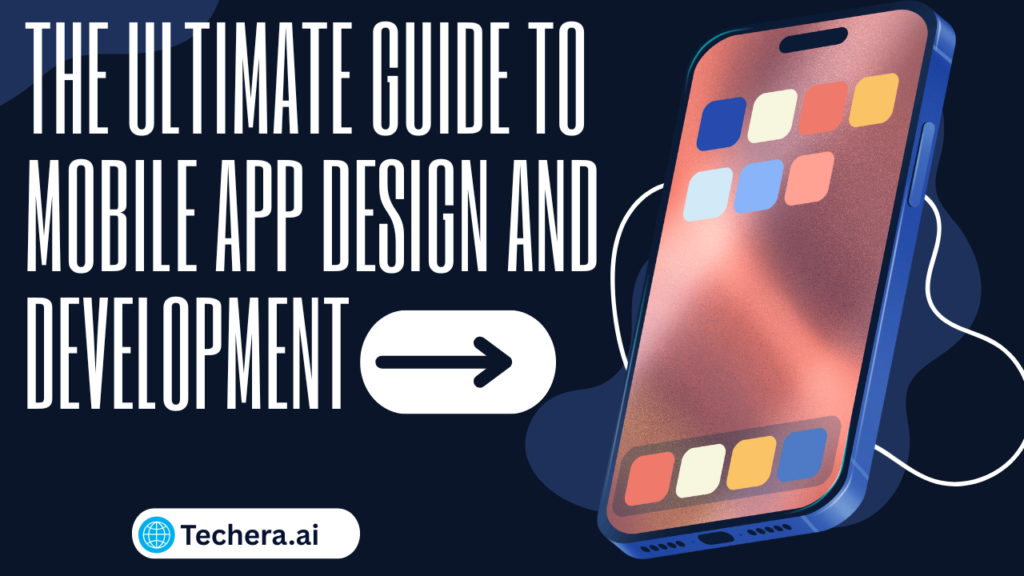
Discover everything you need to know about mobile app design and development in this comprehensive guide. Learn key steps, essential tools, and expert strategies to create user-friendly, high-performing mobile applications that stand out in today’s digital market.
Introduction
Mobile apps have revolutionized how we live, work, and interact. From banking and shopping to learning and entertainment, apps are the backbone of modern convenience. But behind every successful app lies a careful balance of great design and solid development.
Design attracts users, while development ensures everything works seamlessly. Together, they create an engaging, efficient, and memorable digital experience.
Understanding Mobile App Design and Development
Mobile app design focuses on aesthetics and user experience — how the app looks and feels. On the other hand, Mobile app design and development brings that design to life using code and technology.
Think of design as the “face” of the app and development as its “brain.” Both must work hand-in-hand for success.
Planning Your Mobile App
Before writing a single line of code, planning is key.
- Identify your target audience: Understand who will use your app and what they need.
- Specify your objectives: What issue is resolved by your app?
- Research competitors: Learn from existing apps — both their strengths and weaknesses.
A strong plan helps you stay on track and avoid costly redesigns later.
Choosing the Right Platform
Choosing the right platform determines your reach and technical direction.
- Native apps (for iOS and Android) offer the best performance but require separate Mobile app design and development
- Cross-platform apps (like Flutter or React Native) save time and cost by running on multiple platforms.
- Progressive Web Apps (PWA) combine web and mobile functionality for broader accessibility.
Your choice depends on your audience, budget, and performance expectations.
Key Elements of Mobile App Design
App design isn’t just about beauty — it’s about usability.
- UI (User Interface): The layout and appearance are the main focus of UI
- UX (User Experience): Focuses on how users feel while interacting.
A well-designed app reduces friction, encourages interaction, and keeps users coming back.
Wireframing and Prototyping
Wireframes are blueprints of your app’s layout. They help visualize structure before actual design.
Prototypes, on the other hand, allow users to test navigation and features interactively.
Popular tools: Figma, Sketch, Adobe XD, and InVision.
Early feedback from prototypes saves time and ensures you’re on the right track.
Color, Typography, and Visual Hierarchy
Colors evoke emotion — blue for trust, red for urgency, green for growth. Use them wisely.
Typography should be clean and readable across screens. Combine it with a strong visual hierarchy to guide users effortlessly.
Think of your app as a visual story — each color, font, and icon plays a role in user engagement.
App Navigation and Layout

Navigation is like a map — it should guide users naturally.
- Use familiar patterns like bottom tabs or side menus.
- Add micro-interactions (like button animations) to improve user delight.
- Ensure accessibility by supporting screen readers, large text, and color contrast.
The goal is simplicity — users shouldn’t have to think twice while using your app.
Mobile App Development Process
It’s time to develop your design after it’s complete.
- Front-end: The part users interact with.
- Back-end: Handles data, servers, and logic.
- APIs: Connect both ends together seamlessly.
Developers use tools like Swift (iOS), Kotlin (Android), and Flutter for cross-platform apps.
Optimizing App Performance
A slow app is a dead app.
- Compress images and assets to reduce load times.
- Use efficient data management and caching.
- Optimize animations and transitions for smoother performance.
Even milliseconds matter when it comes to keeping users engaged.
Also read Mobile App Design for a Global Audience: Tips for Localization
Security and Data Privacy
Users trust apps with their personal data — don’t break that trust.
- Implement strong authentication and encryption.
- Secure APIs and databases from unauthorized access.
- Follow GDPR and CCPA guidelines for user data handling.
Good security equals brand credibility.
Testing Your App
Testing ensures your app runs flawlessly.
- UI Testing: Checks layout and visuals.
- Functional Testing: Ensures every feature works correctly.
- Performance Testing: Measures speed and responsiveness.
Release a beta version to gather real user feedback before official launch.
Launching Your Mobile App

Launch day is crucial!
- Prepare all assets for App Store and Google Play.
- Use App Store Optimization (ASO) — optimize titles, descriptions, and visuals.
- Promote through social media, email campaigns, and ads.
The first impression matters — make it count.
Post-Launch Maintenance
Your work doesn’t end at launch.
- Fix bugs quickly.
- Listen to user feedback and roll out updates regularly.
- Introduce new features to keep the app fresh and relevant.
Consistency builds trust and long-term success.
Conclusion
Building a Mobile app design and development is a journey — from concept to continuous evolution. Success lies in combining stunning design, robust development, and user-first thinking. When users feel your app was made for them, they’ll keep coming back for more. So, take your time, focus on the details, and never stop improving — because the best apps are those that grow with their users.
FAQs
1. What’s the first step in designing a mobile app?
Start with research — understand your audience, their needs, and what value your app will provide.
2. Which programming languages are best for mobile development?
Swift for iOS, Kotlin for Android, and Flutter or React Native for cross-platform development.
3. How much time does it take to create an application?
Depending on complexity, it can take anywhere from 3 months to over a year.
4. How can I make my app stand out in the app store?
Focus on design, performance, and clear value — plus effective ASO and marketing.
5. Is cross-platform development better than native?
Cross-platform saves time and cost, but native apps offer superior performance and customization.

